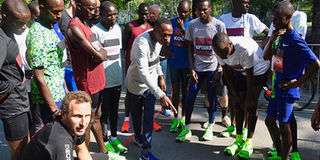Teams in Vienna for Kipchoge challenge’s dry run

Kenya’s Augustine Choge (centre, pointing) and other pacemakers discuss tactics in Vienna on August 31, 2019 during the first rehearsal for Eliud Kipchoge’s October 12 attempt to run the marathon in under two hours. Dubbed “INEOS 1:59 Challenge”, the race will be run between October 12 and 20 in Vienna. PHOTO | OLAF BROCKMANN |
What you need to know:
- In 2017, Kipchoge made his first attempt at running the iconic marathon distance in under two hours but fell just 25 seconds shy in Monza, Italy, at a Nike-organised “Breaking2” event.
- This means he will try and run at least 0.36 percent faster in Vienna to dip under 2:00:00 next month.
A battery of coaches, scientists, athletes and other technical persons have descended on Vienna this weekend for a test run ahead of Eliud Kipchoge’s bid to complete the marathon in under two hours in the Austrian capital next month.
On Saturday, Kenya’s former junior distance running world champion Augustine Choge led a retinue of pacemakers for a dress rehearsal at The Prater (Vienna’s historic park) around where the October 12 attempt will be run.
Dubbed “INEOS 1:59 Challenge,” Kipchoge’s attempt must ensure everything is perfect, from the weather, to athletes’ running shoes, water stations and pacemaker changeovers to diet.
After yesterday’s warm-ups and briefing, the main dry run will be done Sunday.
“This is basically a test event, where we had a 4am start and everything looks pretty smooth,” Dutchman Jos Hermens, director of Kipchoge’s management company, Global Sports Communications, told Nation Sport exclusively from Vienna on telephone.
Next month’s race against the clock is programmed to start at Vienna’s famous imperial bridge — the Reichsbrücke — on October 12, with October 13 to 20 set aside as reserve days should the elements dictate so.
Some 1.2 kilometres from the start, Kipchoge and co. will enter The Prater to begin four laps on the 9.6 kilometre circuit in the Vienna park.
“There are three groups of pacemakers, one which will start with Eliud at the bridge and group two and three which will exchange in the park,” Hermens explained.
The Dutchman knows a thing or two about pacing, and Vienna, as in 1978, he paced Kenyan legend Henry Rono to a then 10,000 metres world record (27 minutes, 22.4 seconds) in Vienna.
“In this test run we are checking out how the pacemakers will run and drop out, and we will be experimenting on a lot of other things also.
“There are about 40 days remaining and there are still many things to be done,” Hermens said.
The INEOS 1:59 Challenge project team, bankrolled by British chemical firm INEOS, has mounted four weather stations in the Vienna Park — two on the ground and two above the trees.
“We want to measure the difference of the wind on the ground and above and the scientists are comparing data over the last seven years to 20 years, and so on.
“To predict what the weather will be like for Eliud’s run is not easy, but we are hoping to get between 10 and 13 degrees, and that’s why we have a window of about 10 days for the event,” Hermens explained.
A team of nutritionists recently spent time with Kipchoge at his Kaptagat training base, just to make sure that his diet is on point.
Hermens said the Olympic champion and world record holder will use the same Nike ZoomX Vaporfly shoe that he wore while running the world record two hours, one minute and 39 seconds at last year’s Berlin Marathon.
It is the same shoe he wore in winning this year’s London Marathon in the second fastest marathon time ever (2:02:38).
In 2017, Kipchoge made his first attempt at running the iconic marathon distance in under two hours but fell just 25 seconds shy in Monza, Italy, at a Nike-organised “Breaking2” event.
This means he will try and run at least 0.36 percent faster in Vienna to dip under 2:00:00 next month.
“But we are not taking chances and we hope to run more than the 26 seconds faster, just to be absolutely sure,” Hermens noted yesterday.





